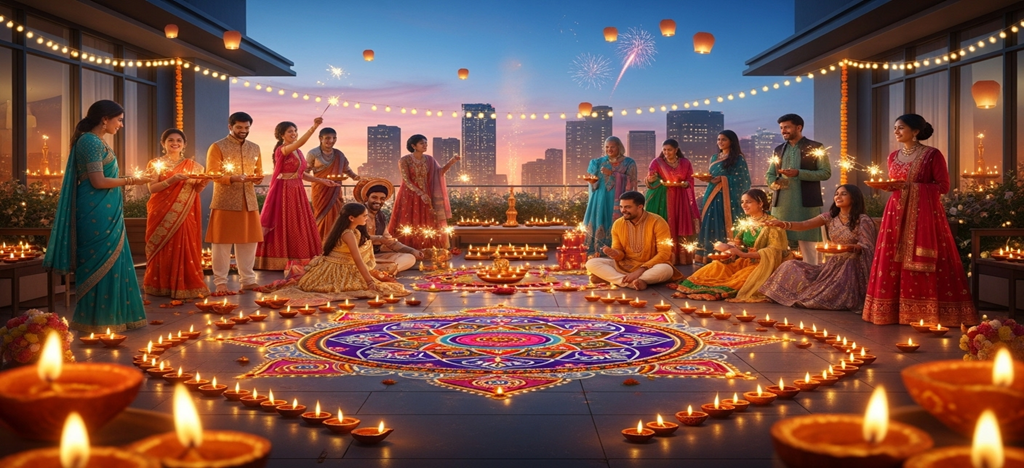Diwali, also known as the Festival of Lights, is one of the most cherished Hindu festivals celebrated worldwide. In 2025, Diwali falls on Monday, October 20, with the main Lakshmi Puja highlighting the festivities. This auspicious occasion marks the victory of good over evil, knowledge over ignorance, and light over darkness. For millions, it’s a time of joy, family gatherings, and renewal.
At Narayan Seva USA, we see Diwali as an opportunity to extend this light to those in need, aligning with our mission to empower differently abled and underprivileged individuals. As a 501(c)(3) nonprofit, we continue the legacy of Narayan Seva Sansthan, founded in 1985, by providing free corrective surgeries, vocational training, and educational support.
This Diwali 2025, let’s explore the festival’s essence and how acts of seva (selfless service) can make it truly meaningful.
The Historical Significance of Diwali
Diwali’s roots trace back thousands of years to ancient Indian scriptures. The festival commemorates Lord Rama’s return to Ayodhya after 14 years of exile and his victory over the demon king Ravana, as narrated in the epic Ramayana. People lit clay lamps (diyas) to guide Rama home, symbolizing the dispelling of darkness. In other traditions, Diwali honors Goddess Lakshmi, the deity of wealth and prosperity, who is believed to visit homes that are clean and illuminated.
Beyond Hinduism, Diwali holds meaning in Jainism, marking Lord Mahavira’s attainment of nirvana, and in Sikhism, celebrating Guru Hargobind’s release from imprisonment. This multi-faceted significance makes Diwali a unifying festival across cultures. In 2025, as we approach October 20, reflecting on these stories reminds us of resilience and hope—values central to Narayan Seva USA’s work in rehabilitating those facing physical challenges.
Traditional Diwali Celebrations and Customs
Diwali spans five days, each with unique rituals. It begins with Dhanteras on October 18 in 2025, when people buy gold or utensils for prosperity. Naraka Chaturdashi, or Choti Diwali, follows on October 19, focusing on cleansing and warding off evil. The main day, Diwali on October 20, involves Lakshmi Puja, where families pray for blessings.
Homes are decorated with rangoli—intricate patterns made from colored powders, rice, or flowers—and strings of lights. Diyas are lit to invite positive energy, and fireworks light up the night sky. Sweets like laddoos and barfis are shared, symbolizing sweetness in life. Gift-giving and feasting strengthen community bonds.
Environmentally conscious celebrations are gaining traction, with eco-friendly diyas and reduced fireworks to minimize pollution. These traditions not only preserve cultural heritage but also promote values like generosity, which resonate with charitable efforts during the festival.
Diwali Celebrations in the USA: A Blend of Tradition and Modernity
In the United States, Diwali has evolved into a vibrant cultural event for the Indian diaspora and beyond. Cities like New York, Chicago, and Los Angeles host grand parades, cultural shows, and fairs. The White House has recognized Diwali since 2003, with presidents hosting receptions to honor the festival.
For many Indian-Americans, Diwali 2025 will involve virtual pujas, community potlucks, and online shopping for ethnic wear. Temples organize events with dance performances like Garba and Dandiya, blending nostalgia with American flair. Schools and workplaces increasingly acknowledge Diwali as a holiday, fostering inclusivity.
This adaptation highlights Diwali’s universal appeal—promoting unity in diversity. At Narayan Seva USA, based in California, we encourage incorporating seva into these celebrations, such as donating to causes that uplift the underprivileged, making the festival more impactful.
How Narayan Seva USA Embodies the Spirit of Diwali
Community coming together to support differently-abled individuals during festive times.
Narayan Seva USA’s mission aligns perfectly with Diwali’s themes of light and prosperity for all. Since our parent organization, Narayan Seva Sansthan, was established in 1985 by Padma Shri Kailash ji ‘Manav’, we’ve performed over 449,000 free corrective surgeries for polio and other disabilities. We’ve distributed nearly 400,000 calipers and 273,000 tricycles, enabling mobility and independence.
Our vocational training centers, started in 2001, teach skills like mobile repairing, sewing, and computer literacy to 3,411 individuals, empowering them economically. The Narayan Children Academy, launched in 2015, provides free digital education to underprivileged kids.
Events like Divyang Vivah (2008) facilitate free marriages for the differently-abled, promoting social inclusion. During crises, like the 2020 COVID relief, we distributed meals and essentials. This Diwali, our ‘World of Humanity’ vision in 2025 calls for an inclusive society, where seva illuminates lives just as diyas brighten homes.
Ways to Contribute This Diwali with Narayan Seva USA
This Diwali 2025, transform your celebrations into acts of kindness. Donate to support free surgeries or vocational programs—every contribution brings light to someone’s life. Volunteer your time for awareness campaigns or events, embodying seva.
Host a Diwali fundraiser, where proceeds go toward education for underprivileged children. Share our stories on social media to amplify our reach. Corporate partners like Google and Microsoft have joined us; individuals can too. Visit narayansevausa.org to learn more and contribute.
By giving back, you honor Diwali’s essence of prosperity shared with all.
Conclusion: Let Your Light Shine Through Seva
As Diwali 2025 approaches on October 20, let’s commit to spreading hope beyond our homes. At Narayan Seva USA, we believe true celebration lies in uplifting others. Join us in creating a brighter, more inclusive world. Happy Diwali!








